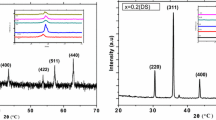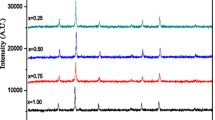Abstract
Polycrystalline Ni0.3Cu0.2Zn0.5Fe2O4 and Ni0.3Cu0.2Zn0.5Sc0.05Fe1.95O4 compounds have been prepared by standard solid-state reaction technique and sintered at 1000, 1100, 1150, 1200, and 1250 °C for 5 h in air. The effect of sintering temperature on the structural, morphological, magnetic, dielectric, and electrical properties of these spinel ferrites has been studied thoroughly and comparatively. Formation of the single-phase cubic spinel structure of these compositions is confirmed by X-ray diffraction analysis. The lattice constant increases with sintering temperature as well as with 5% scandium (Sc3+) doping in Ni–Cu–Zn ferrite. Surface morphology reveals that the grain size increases with sintering temperature. Among the prepared ferrites, Ni0.3Cu0.2Zn0.5Sc0.05Fe1.95O4 has the maximum density (5.05 × 103 kg/m3) at sintering temperature 1150 °C, which gives the highest value of initial permeability. It is observed that initial permeability varies with sintering temperature, and it gives the maximum value at optimum sintering temperature. It is noted that Curie temperature decreases with 5% Sc3+ ions doping, whereas it slightly increases with increasing sintering temperature for both compositions. Ni0.3Cu0.2Zn0.5Fe2O4 compound shows the highest Curie temperature 418 °C. Dielectric constant, dielectric loss factor and AC electrical conductivity decrease with 5% Sc3+ ions doping in Ni–Cu–Zn ferrite. The initial permeability decreases sharply at Curie temperature, which indicates a high degree of compositional homogeneity. The ‘Hopkinson’ peak is observed just below the Curie temperature in the real part of initial permeability versus temperature graphs. The mechanism of dielectric polarization and electrical conductivity has been explained based on the electron hopping between Fe3+ and Fe2+ ions. The variation trend of complex impedance and AC electrical conductivity reveals the semiconducting behavior of the ferrite samples. Formation of partial semicircles in the Z/-axis indicates that relaxation process is non-Debye type. The investigated ferrites show relatively high initial permeability, low magnetic loss, and low electrical conductivity in a wide frequency range, which make them potential candidate for various practical applications such as small and compact power suppliers for computers, microprocessors, microwave electronic devices, etc.
















Similar content being viewed by others
Availability of data and material
The raw/processed data required to reproduce these findings cannot be shared at this time as the data are a part of the ongoing studies. Partial data can be shared upon request. Reagent-grade powders of CuO (≥ 99.9%), NiO (≥ 99.9%), ZnO (≥ 99.9%), Fe2O3 (≥ 99.9%), and Sc2O3 (≥ 99.99%) were used to prepare the proposed ferrites. All the raw oxides have been procured from Sigma Aldrich, Germany.
References
A. Namai, M. Yoshikiyo, K. Yamada et al., Hard magnetic ferrite with a gigantic coercivity and high frequency millimeter wave rotation. Nat. Commun. 3(1035), 1–6 (2012). https://doi.org/10.1038/ncomms2038
A.K.M. Akther Hossain, S.T. Mahmud, M. Seki, T. Kawai, H. Taba, Structural, electrical transport, and magnetic properties of Ni1−xZnxFe2O4. J. Magn. Magn. Mater. 312, 210–219 (2007). https://doi.org/10.1016/j.jmmm.2006.09.030
B.C. Das, F. Alam, A.K.M. Akther Hossain, The crystallographic, magnetic, and electrical properties of Gd3+ substituted Ni–Cu–Zn mixed ferrites. J. Phys. Chem. Solids (2020). https://doi.org/10.1016/j.jpcs.2020.109433
S.T. Assar, H.F. Abosheiasha, A.R. El Sayed, Effect of γ-rays irradiation on structural, magnetic, and electrical properties of Mg–Cu–Zn and Ni–Cu–Zn ferrites. J. Magn. Magn. Mater. 421, 355–367 (2017). https://doi.org/10.1016/j.jmmm.2016.08.028
P. Lathiya, M. Kreuzer, J. Wang, RF complex permeability spectra of Ni–Cu–Zn ferrites prepared under different applied hydraulic pressures and durations for wireless power transfer (WPT) applications. J. Magn. Magn. Mater. (2020). https://doi.org/10.1016/j.jmmm.2019.166273
J. Xiang, X. Shen, F. Song, M. Liu, One-dimensional NiCuZn ferrite nanostructures: fabrication, structure, and magnetic properties. J. Solid State Chem. 183, 1239–1244 (2010). https://doi.org/10.1016/j.jssc.2010.03.041
M.C. Dimri, A. Verma, S.C. Kashyap, D.C. Dube, O.P. Thakur, C. Prakash, Structural, dielectric and magnetic properties of NiCuZn ferrite grown by citrate precursor method. Mater. Sci. Eng. B 133, 42–48 (2006). https://doi.org/10.1016/j.mseb.2006.04.043
M.H. Rashid, A.K.M. Akther Hossain, Structural, morphological and electromagnetic properties of Sc3+ doped Ni–Cu–Zn ferrites. Results Phys. 11, 888–895 (2018). https://doi.org/10.1016/j.rinp.2018.10.050
B. Parvatheeswara Rao, K.H. Rao, Direct current resistivity studies of various polycrystalline Ni–Zn–Sc ferrites. J. Appl. Phys. 80, 6804–6808 (1996). https://doi.org/10.1063/1.363808
A. Gholizadeh, E. Jafari, Effects of sintering atmosphere and temperature on structural and magnetic properties of Ni–Cu–Zn ferrite nano-particles: magnetic enhancement by a reducing atmosphere. J. Magn. Magn. Mater. 422, 328–336 (2017). https://doi.org/10.1016/j.jmmm.2016.09.029
M.A. Almessiere, Y. Slimani, H. Gungunes, V.G. Kostishyn, S.V. Trukhanov, A.V. Trukhanov, A. Baykal, Impact of Eu3+ ion substitution on structural, magnetic and microwave traits of Ni–Cu–Zn spinel ferrites. Ceram. Int. 46(8), 11124–11131 (2020). https://doi.org/10.1016/j.ceramint.2020.01.132
A.K. Singh, T.C. Goel, R.G. Mendiratta, O.P. Thakur, C. Prakash, Magnetic properties of Mn-substituted Ni–Zn ferrites. J. Appl. Phys. 92, 3872–3876 (2002)
V.J. Angadi, L. Choudhury, K. Sadhana, H.-L. Liu, R. Sandhya et al., Structural, electrical and magnetic properties of Sc3+ doped Mn–Zn ferrite nanoparticles. J. Magn. Magn. Mater. 424, 1–11 (2017). https://doi.org/10.1016/j.jmmm.2016.10.050
N. Rezlescu, E. Rezlescu, P.D. Popa, C. Doroftei, M. Ignat, Scandium substituted nickel-cobalt ferrite nanoparticles for catalyst applications. Appl. Catal. B 158–159, 70–75 (2014). https://doi.org/10.1016/j.apcatb.2014.03.052
J.B. Nelson, D.P. Riley, An experimental investigation of extrapolation methods in the derivation of accurate unit-cell dimensions of crystals. Proc. Phys. Soc. 57, 160–177 (1945). https://doi.org/10.1088/0959-5309/57/3/302
M.H. Rashid, J. Rabeya, M.H. Doha, O. Islam, P. Reith, G. Hopman, H. Hilgenkamp, Characterization of single step electrodeposited Cu2ZnSnS4 thin films. J. Opt. 47, 256–262 (2018). https://doi.org/10.1007/s12596-018-0463-0
E.H. El-Ghazzawy, M.A. Amer, Structural, elastic and magnetic studies of the as-synthesized Co1−xSrxFe2O4 nanoparticles. J. Alloys Compd. 690, 293–303 (2017). https://doi.org/10.1016/j.jallcom.2016.08.135
M.I. Mendelson, Average grain size in polycrystalline ceramics. J. Am. Ceram. Soc. 52, 443–446 (1969). https://doi.org/10.1111/j.1151-2916.1969.tb11975.x
S. Shanmugam, B. Subramanian, Evolution of phase pure magnetic cobalt ferrite nanoparticles by varying the synthesis conditions of polyol method. Mater. Sci. Eng. B (2020). https://doi.org/10.1016/j.mseb.2019.114451
R. Dou, H. Cheng, J. Ma, S. Komarneni, Manganese doped magnetic cobalt ferrite nanoparticles for dye degradation via a novel heterogeneous chemical catalysis. Mater. Chem. Phys. (2020). https://doi.org/10.1016/j.matchemphys.2019.122181
R. Singh Yadav, I. Kuritka, J. Vilcakova, T. Jamatia, M. Machovsky et al., Impact of sonochemical synthesis condition on the structural and physical properties of MnFe2O4 spinel ferrite nanoparticles. Ultrasonics Sonochem. (2020). https://doi.org/10.1016/j.ultsonch.2019.104839
L. Vegard, Die konstitution der mischkristalle und die raumfüllung der atome. Zeitschrift für Physik. 5, 17–26 (1921). https://doi.org/10.1007/BF01349680
M.D. Rahaman, T. Nusrat, R. Maleque, A.K.M. Akther Hossain, Investigation of structural, morphological and electromagnetic properties of Mg0.25Mn0.25Zn0.5−xSrxFe2O4 ferrites. J. Magn. Magn. Mater. 451, 391–406 (2018). https://doi.org/10.1016/j.jmmm.2017.11.066
F.L. Zabotto, A.J. Gualdi, A.J.A. de Oliveira, J.A. Eiras, D. Garcia, Effect of ferrite concentration on dielectric and magnetoelectric properties in (1–x)Pb(Mg1/3Nb2/3)0.68Ti0.32O3 + (x)CoFe2O4 particulate composites. J. Ferroelectr. 428, 122–128 (2012). https://doi.org/10.1080/00150193.2012.674434
Z. Pedzich, M.M. Bucko, M. Krolikowski, M. Bakalrska, J. Babiaz, Microstructure and properties of Mg–Zn ferrite as a result of sintering temperature. J. Eur. Ceram. Soc. 24, 1053 (2004). https://doi.org/10.1016/S0955-2219(03)00386-8
A. Loganathan, K. Kumar, Effects on structural, optical, and magnetic properties of pure and Sr-substituted MgFe2O4 nanoparticles at different calcination temperatures. Appl. Nanosci. 6, 629–639 (2016). https://doi.org/10.1007/s13204-015-0480-0
M.F. Al-Hilli, S. Li, K.S. Kassim, Gadolinium substitution and sintering temperature dependent electronic properties of Li–Ni ferrite. Mater. Chem. Phys. 128, 127–132 (2011). https://doi.org/10.1016/j.matchemphys.2011.02.064
M.D. Rahaman, K.K. Nahar, M.N.I. Khan, A.K.M. Akther Hossain, Synthesis, structural, and electromagnetic properties of Mn0.5Zn0.5−xMgxFe2O4 (x = 0.0, 0.1) polycrystalline ferrites. Phys. B 481, 156–164 (2016). https://doi.org/10.1016/j.physb.2015.11.008
A. Globus, P. Duplex, M. Guyot, Determination of initial magnetization curve from crystallites size and effective anisotropy field. IEEE Trans. Magn. 7, 617–622 (1971). https://doi.org/10.1109/TMAG.1971.1067200
M.D. Rahaman, M. Dalim Mia, M.N.I. Khan, A.K.M. Akther Hossain, Study the effect of sintering temperature on structural, microstructural and electromagnetic properties of 10% Ca-doped Mn0.6Zn0.4Fe2O4. J. Magn. Magn. Mater. 404, 238–249 (2016). https://doi.org/10.1016/j.jmmm.2015.12.029
N. Bloembergen, Magnetic resonance in ferrites. Proc. IRE. 44, 1259–1269 (1956). https://doi.org/10.1109/JRPROC.1956.274949
J.L. Snoek, Dispersion and absorption in magnetic ferrites at frequencies above one Mc/s. Physica 14, 207–217 (1948). https://doi.org/10.1016/0031-8914(48)90038-X
K. Overshott, The causes of the anomalous loss in amorphous ribbon materials. IEEE Trans. Magn. 17, 2698–2700 (1981). https://doi.org/10.1109/TMAG.1981.1061648
E. Cedillo, J. Ocampo, V. Rivera, R. Valenzuela, An apparatus for the measurement of initial magnetic permeability as a function of temperature. J. Phys. E 13, 383–386 (1980). https://doi.org/10.1088/0022-3735/13/4/005
M. Louis Néel, Propriétés magnétiques des ferrites; ferrimagnétisme et antiferromagnétisme. Ann. Phys. 12, 137–198 (1948). https://doi.org/10.1051/anphys/194812030137
L.R. Maxwell, S.J. Pickart, Magnetic and crystalline behavior of certain oxide systems with spinel and perovskite structures. Phys. Rev. 96, 1501–1505 (1954). https://doi.org/10.1103/PhysRev.96.1501
B. Parvatheeswara Rao, P.S.V. Subba Rao, K.H. Rao, X-ray and magnetic studies of scandium substituted Ni–Zn ferrites. IEEE Trans. Magn. 33, 4454–4458 (1997). https://doi.org/10.1109/20.649881
R. Valenzuela, Magnetic Ceramics. (Cambridge University Press, Cambridge, 1994). www.cambridge.org/9780521364850.
E.C. Stoner, E.P. Wohlfarth, A mechanism of magnetic hysteresis in heterogeneous alloys. Philos. Trans. R. Soc. Lond. A 240, 599 (1948). https://doi.org/10.1098/rsta.1948.0007
M. Kamran, M. Anis-ur-Rehman, Enhanced transport properties in Ce doped cobalt ferrites nanoparticles for resistive RAM applications. J. Alloys Compd. (2020). https://doi.org/10.1016/j.jallcom.2019.153583
N. Rezlescu, E. Rezlescu, Dielectric properties of copper containing ferrites. Phys. Status Solidi (a) 23, 575 (1974). https://doi.org/10.1002/pssa.2210230229
C.G. Koops, On the dispersion of resistivity and dielectric constant of some semiconductors at audiofrequencies. Phys. Rev. 83, 121–124 (1951). https://doi.org/10.1103/PhysRev.83.121
S. Ul Haque, K. Kumar Saikia, G. Murugesan, S. Kalainathan, A study on dielectric and magnetic properties of lanthanum substituted cobalt ferrite. J. Alloys Compd. 701, 612–618 (2017). https://doi.org/10.1016/j.jallcom.2016.11.309
A.K. Nikumbh, R.A. Pawar, D.V. Nighot, G.S. Gugale, M.D. Sangale, M.B. Khanvilkar, A.V. Nagawade, Structural, electrical, magnetic and dielectric properties of rare-earth substituted cobalt ferrites nanoparticles synthesized by the co-precipitation method. J. Magn. Magn. Mater. 355, 201–209 (2014). https://doi.org/10.1016/j.jmmm.2013.11.052
M.H. Rashid, Investigation of structural, morphological and electromagnetic properties of scandium doped nickel-copper-zinc ferrites. M. Phil thesis, Bangladesh University of Engineering and Technology, Bangladesh. 2019. pp. 77–79. http://lib.buet.ac.bd:8080/xmlui/handle/123456789/5458.
A. ur Rahman, M.A. Rafiq, S. Karim, K. Maaz, M. Siddique, M.M. Hasan, Reduced conductivity and enhancement of Debye orientation polarization in lanthanum doped cobalt ferrite nanoparticles. Phys. B 406, 4393–4399 (2011). https://doi.org/10.1016/j.physb.2011.08.094
N. Singh, A. Agarwal, S. Sanghi, Dielectric relaxation, conductivity behaviour and magnetic properties of Mg substituted Ni-Li ferrites. J. Alloys Compd. 509, 7543–7548 (2011). https://doi.org/10.1016/j.jallcom.2011.04.126
A.A. Birajdar, S.E. Shirsath, R.H. Kadam, S.M. Patange, D.R. Mane, A.R. Shitre, Frequency and temperature dependent electrical properties of Ni0.7Zn0.3CrxFe2−xO4 (0 ≤ x ≤ 0.5). Ceram. Int. 38, 2963–2970 (2012). https://doi.org/10.1016/j.ceramint.2011.11.074
A.M. Shaikh, S.S. Bellad, B.K. Chougule, Temperature and frequency-dependent dielectric properties of Zn substituted Li-Mg ferrites. J. Magn. Magn. Mater. 195, 384–390 (1999). https://doi.org/10.1016/S0304-8853(99)00138-9
M. Abdullah Dar, K. Majid, K. Mujasam Batoo, R.K. Kotnala, Dielectric and impedance study of polycrystalline Li0.35−0.5xCd0.3NixFe2.35−0.5xO4 ferrites synthesized via a citrate-gel auto combustion method. J. Alloys Compd. 632, 307–320 (2015). https://doi.org/10.1016/j.jallcom.2015.01.190
K. Lily, K. Kumari, K. Prasad, R.N.P. Choudhary, Impedance spectroscopy of (Na0.5Bi0.5)(Zr0.25Ti0.75)O3 lead-free ceramic. J. Alloys Compd. 453, 325–331 (2008). https://doi.org/10.1016/j.jallcom.2006.11.081
M. Nazrul Islam, A.K.M. Akther Hossain, Enhancement of Neel temperature and electrical resistivity of Mn–Ni–Zn ferrites by Gd3+ substitution. J. Mater. Res. Technol. 8(1), 208–216 (2019). https://doi.org/10.1016/j.jmrt.2017.11.006
Acknowledgements
Md. Harun-Or-Rashid is grateful to the Solid-State Physics Laboratory of Bangladesh University of Engineering and Technology (BUET), Dhaka, Bangladesh for allowing to do this research. This research is financially supported by Bangladesh University of Textiles (BUTEX), Dhaka, Bangladesh (Code-3632104, FY 2019-2020, S/N 14, 01.10.2019).
Funding
This research is financially supported by Bangladesh University of Textiles (BUTEX), Dhaka, Bangladesh (Code-3632104, FY 2019-2020, S/N 14, 01.10.2019).
Author information
Authors and Affiliations
Contributions
MH-O-R: conceptualization, funding acquisition, data curation, formal analysis, investigation, visualization, writing—review and editing. MNI: formal analysis, writing—review and editing. MA: formal analysis, writing—review and editing. AKMAH: lab facilities, overall supervision.
Corresponding author
Ethics declarations
Conflict of interest
The authors declare that they have no known competing financial interests or personal relationships that could have appeared to influence the work reported in this paper. Also there is no conflict of interest for this submission.
Additional information
Publisher's Note
Springer Nature remains neutral with regard to jurisdictional claims in published maps and institutional affiliations.
Rights and permissions
About this article
Cite this article
Harun-Or-Rashid, M., Islam, M.N., Arifuzzaman, M. et al. Effect of sintering temperature on the structural, morphological, electrical, and magnetic properties of Ni–Cu–Zn and Ni–Cu–Zn–Sc ferrites. J Mater Sci: Mater Electron 32, 2505–2523 (2021). https://doi.org/10.1007/s10854-020-05018-7
Received:
Accepted:
Published:
Issue Date:
DOI: https://doi.org/10.1007/s10854-020-05018-7




